قد تستمر الأعمال التجارية بشكل جيد في ظروف السوق المتغيرة، ولكن لكي تزدهر تحتاج إلى تحسين أنشطة سلسلة القيمة لضمان أداء متفوق. غالبًا ما تكون الشركات الراسخة هي تلك الشركات التي تعمل باستمرار على تحسين القيمة التي تقدمها للعملاء والمساهمين، بالإضافة إلى أصحاب المصلحة الآخرين المعنيين.
لكن الأمر لا يتعلق فقط بتحسين المنتجات والخدمات، بل يجب عليك أيضًا إجراء تحليل دقيق للخدمات اللوجستية الواردة والصادرة وإدارة الموارد البشرية والعمليات التشغيلية الأخرى لتوسيع هوامش الربح.
ولهذا السبب بالتحديد يعتمد المديرون ذوو التفكير المستقبلي على تحليل سلسلة القيمة (VCA) لاكتساب ميزة تنافسية حقيقية في مجال عملهم. تتطلب هذه الممارسة التحسين المستمر للأنشطة الأساسية والداعمة في الأعمال التجارية برؤية لبناء ولاء العملاء والتمتع بتوفير في التكاليف، وكل ذلك يؤدي إلى ميزة تنافسية من خلال خلق قيمة ثابتة. 🌱
سنستكشف في هذه المقالة
- مفهوم سلسلة القيمة
- دورها في تحسين نماذج الأعمال
- عملية إجراء تحليل لسلسلة القيمة - من منظوري التكلفة وتمييز المنتجات
ما هو تحليل سلسلة القيمة؟
استكشف الخبير الاقتصادي البارز والأستاذ في كلية هارفارد للأعمال مايكل بورتر لأول مرة مفاهيم سلسلة القيمة و تحليل سلسلة القيمة في كتابه الميزة التنافسية: خلق الأداء المتفوق والحفاظ عليه .
تشير سلسلة القيمة إلى جميع العمليات طوال دورة حياة المنتج أو الخدمة بأكملها، بدءًا من مرحلة البحث والتطوير وصولاً إلى مرحلتي التوزيع والمبيعات. يمكن تحليل كل عملية في السلسلة من حيث القيمة الإضافية التي تضيفها إلى المنتج أو الخدمة النهائية، وهذا هو بالضبط ما يدور حوله تحليل سلسلة القيمة.
إنها عملية تحليل الأنشطة الأساسية والداعمة التي ينطوي عليها تقديم المنتج والحفاظ على الأعمال التجارية. والغرض من ذلك هو تحديد العمليات التي تساهم بشكل معقول في القيمة التي يقدمها المنتج أو الخدمة النهائية.

عبر كلية هارفارد للأعمال على الإنترنت يساعد التحليل الدقيق لسلسلة القيمة الشركات على فتح رؤى جديدة تمكنها من تقديم أقصى قيمة لعملائها وأصحاب المصلحة. في نهاية التحليل الناجح، يجب أن يكون المديرون قادرين على:
- خفض التكاليف عبر سلاسل القيمة
- تحديد العمليات الأساسية في التسليم
- تحديد فرص التحسينات التشغيلية والتكنولوجية
- تحسين مبادرات التسويق والمبيعات من أجل تجربة أفضل للعملاء
نصيحة: هل تبحث عن تحليل على غرار بورتر للقوى التنافسية في السوق وتأثيرها على سلاسل القيمة الخاصة بك؟ جرّب ClickUp نموذج القوى الخمس لبورتر لتصورات سريعة 🌹
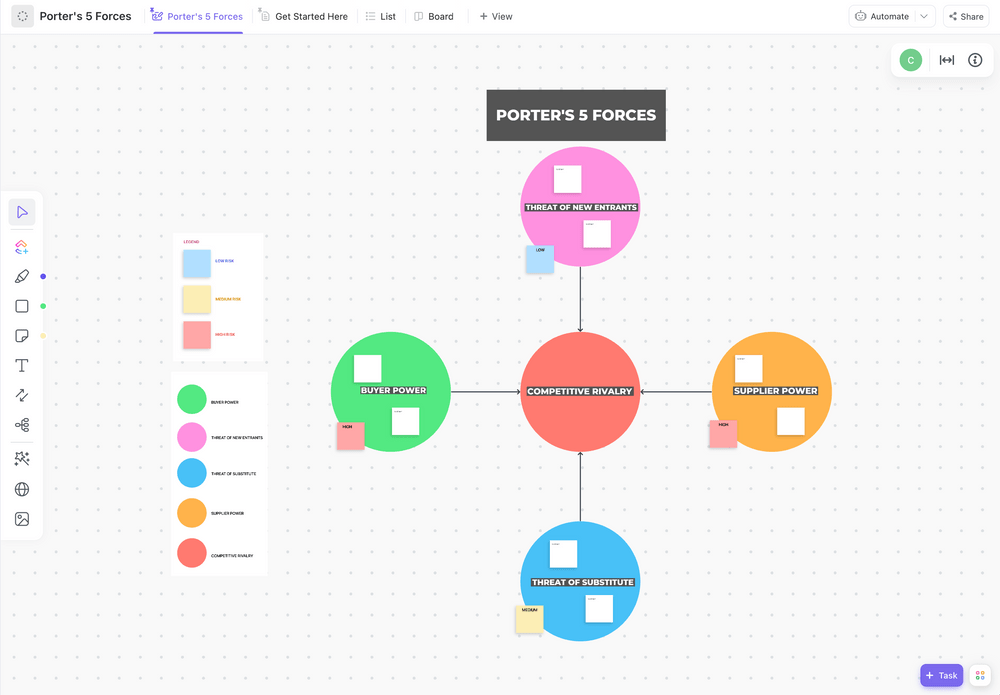
بالنسبة للشركات التي تسعى إلى تحسين فهم الصناعة وصياغة استراتيجيات مؤثرة، يثبت هذا القالب الديناميكي سهل الاستخدام والديناميكي أنه رصيد لا يقدر بثمن
/ctaBtn/الأخضر https://app.clickup.com/signup?template=t-216263765 تنزيل هذا القالب /%ctaBtntn/
كيف يمكن لتحليل سلسلة القيمة أن يفيد الشركات؟
بعض الفوائد الرئيسية المستمدة من تحليل سلسلة القيمة لبورتر تشمل:
- تمايز المنتجات: من الفوائد الأكثر وضوحًا لتحليل سلسلة القيمة الحفاظ على الأداء المتفوق للتمتع بولاء العملاء الدائم. ويشمل ذلك إعادة النظر في العمليات والاستراتيجيات الحالية لتطوير منتجات وميزات وخدمات جديدة تتماشى مع احتياجات العملاء المتطورة في سيناريو تنافسي
- تخفيض التكلفة: يعطي تحليل سلسلة القيمة نظرة شاملة للعمليات التي تضيف أو تطرح قيمة في نموذج عملك الحالي,المساعدة في التعرف على الكفاءات وأوجه القصور. يمكن أن تساعدك هذه الرؤى في تحديد العمليات التي يمكن أتمتتها وإزالتها وتحسينها لزيادة هوامش الربح
- الابتكار الموجه نحو النمو: يمكن أن يكشف التحليل الدقيق لإطار سلسلة القيمة أيضًا عن العمليات التجارية المتكررة والتبعيات المعقدة التي قد تعيق النمو والإنتاجية، مما يتيح لك الفرصة لتعديل العمليات المعنية
وبشكل عام، يمكنك تحقيق التمايز التشغيلي، مما يولد مزايا متميزة يصعب على منافسيك تكرارها. وعلى المدى الطويل، يُترجم ذلك إلى إدراك أقوى للعلامة التجارية وتحسين الربحية على أساس سنوي. 📆
ما الذي يجب تضمينه في تحليل سلسلة القيمة الخاصة بك
يشمل تحليل سلسلة القيمة استكشاف العمليات عبر فئتين رئيسيتين: الأنشطة الأولية و الأنشطة الثانوية
تتكون الوظائف أو الأنشطة الأساسية من العمليات الأساسية لتطوير وتوزيع أي منتج أو خدمة. وهي تضيف قيمة إلى العرض مباشرة. ويتطلب منك التحليل النموذجي للوظائف الأولية استكشاف:
- الخدمات اللوجستية الواردة: تغطي سلسلة التوريد؛ وتشمل الأمثلة على ذلك استلام المواد الخام والتخزين
- العمليات: إجراءات مثل التصنيع التي تحول المواد الخام إلى سلع تامة الصنع
- الخدمات اللوجستية الصادرة: تشمل أنشطة مثل التعبئة والتغليف والفرز والشحن التي تتيح تسليم المنتج أو الخدمة النهائية
- أنشطة المبيعات والتسويق: وهي أنشطة ترويجية وأنشطة قمع المبيعات
- خدمة ما بعد البيع: العمليات المتعلقة بخدمة العملاء والإصلاح والصيانة
من ناحية أخرى، لا تلعب الأنشطة الثانوية دورًا مباشرًا في المبيعات أو الإنتاج ولكنها تدعم الوظائف الأساسية بدلاً من ذلك. يمكنك أن تتوقع من هذه الأنشطة تحسين كفاءة وفعالية نظيراتها الأساسية. تشمل رؤوس الأنشطة الثانوية الرئيسية الأربعة ما يلي:
- المشتريات: ترتبط ارتباطًا وثيقًا بالجزء اللوجستي الوارد من الأنشطة الأولية؛ وتغطي مجالات مثل معالجة الطلبات وإدارة الموارد مثل المخزون
- البشرية إدارة الموارد البشرية: تشمل تعيين الموظفين وتدريبهم والاحتفاظ بهم وتعويضهم
- صيانة البنية التحتية: تغطي الأبحاث والتطورات التي تم إجراؤها لتحسين العمليات التجارية وإدارة النفقات العامة والتخطيط المالي
- التطوير التكنولوجي: يساعد على خفض التكاليف المتعلقة بالتكنولوجيا وتعزيز أتمتة العمليات
من خلال النظر في جميع هذه المكونات أثناء إجراء تحليل سلسلة القيمة، يمكنك استخلاص استراتيجية تشغيلية ومراقبة أفضل للجودة.
كيفية إجراء تحليل سلسلة القيمة
يتطلب تحليل سلسلة القيمة تجزئة العمليات الأولية والثانوية إلى جيوب متشابهة من الناحية الاستراتيجية، مما يسمح بإدارة سلسلة القيمة بشكل مبسط.
هناك نهجان رئيسيان يمكنك اعتمادهما لتحليل سلسلة القيمة:
- في النهج الأول، تهدف في النهج الأول إلى الحصول على ميزة التكلفة في الصناعة للتمتع بزيادة الربحية
- يركز النهج الثاني على تحقيق تمايز فريد من نوعه في المنتج الذي يقدّره العملاء ويسمح لك بفرض أسعار مميزة على منافسيك
دعنا نستكشف كلا النهجين واحدًا تلو الآخر. سنرى أيضًا كيف انقر فوق ، عمل كامل و حل إدارة المشروع يمكن أن يساعدك في إجراء تحليل سلسلة القيمة بسرعة وفعالية. 💡
النهج 1: تحليل ميزة التكلفة
من من منظور ميزة التكلفة، يهدف تحليل سلسلة القيمة إلى مساعدتك على خفض تكلفة إنتاج أو تقديم المنتج أو الخدمة التي تبيعها. والنتيجة؟ يمكنك بيع عرضك بسعر أقل من منافسيك دون المساس بالهوامش. وعادةً ما تكون عملية تحليل القيمة المضافة لميزة التكلفة عملية من خمس خطوات:
الخطوة 1: تحديد الأنشطة الأساسية والثانوية
تتمثل الخطوة الأولى لإجراء تحليل سلسلة القيمة لميزة التكلفة في تحديد الأنشطة الأساسية والثانوية في عملياتك التجارية. والفكرة هي تقدير نطاق تخفيضات التكلفة التي يمكن تحقيقها بشكل واقعي.
والقاعدة العامة هي توخي الحذر أثناء تخفيض تكاليف الأنشطة الأساسية لأنها مرتبطة مباشرة بمنتجك. لا جدوى من إدخال تعديلات تضر بتجربة المستخدم.
هناك طريقة جيدة لتنظيم المعلومات التي تحتاجها خلال هذه الخطوة وهي استخدام مجموعة ClickUp لإدارة المنتجات . إنها مثالية لتركيز تحليل سلسلة القيمة الخاصة بك لأي صناعة أو مجال متخصص - اكتب مستندات العملية، وقم ببناء خرائط الطريق، و تصور دورة حياة المنتج بالكامل .

صياغة التميز في المنتج: من المواصفات إلى المراحل الرئيسية مع إدارة المنتجات في ClickUp
هل تحتاج إلى بداية سريعة؟ احصل على الراحة مع قالب السبورة البيضاء لسلسلة القيمة ClickUp . يتيح لك إطاره المرئي المصمم مسبقًا تنظيم جميع أنشطتك الأساسية والثانوية وتحديد علاقتها بهامش الربح. اطلب من فريق التحليل الخاص بك ربط المهام أو المستندات أو حتى المنتجات الفردية مباشرة في القالب والتعاون بسلاسة. 😎
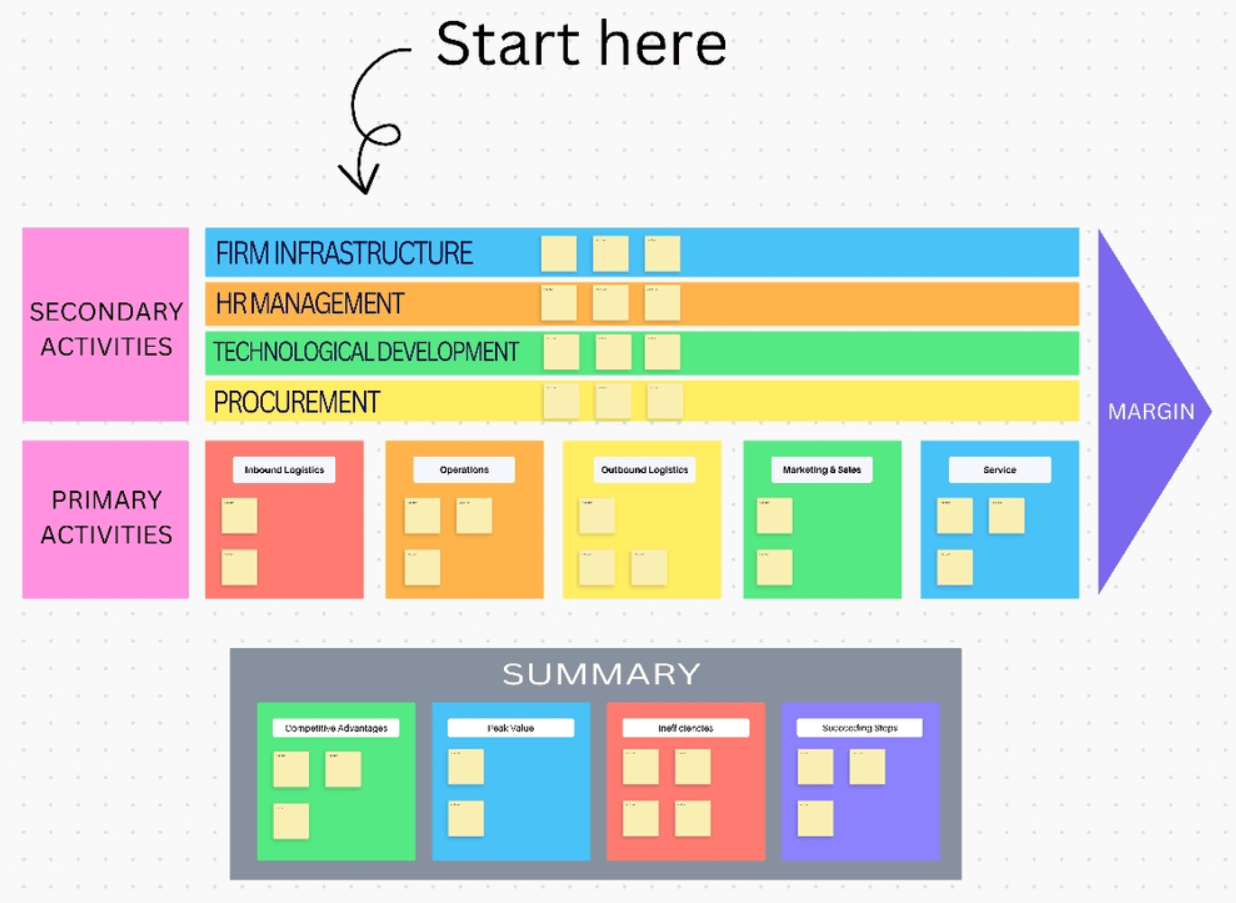
يساعدك قالب السبورة البيضاء لسلسلة القيمة ClickUp على تحليل أنشطة شركتك وتقديم قيمة إضافية لعملائك
إذا كنت تدير أكثر من نشاط تجاري واحد، فأنشئ قوالب متعددة لتخطيط سلاسل القيمة الفردية في مساحات عمل مخصصة للمشروع داخل ClickUp.
/ctaBtn/الأخضر https://app.clickup.com/signup?template=t-381102045 تنزيل هذا القالب /%ctaBtntn/
الخطوة 2: سجل مساهمة كل عملية في مجموعة التكاليف
تتمثل الخطوة التالية في معرفة حصة كل نشاط في التكلفة الإجمالية للإنتاج والتسليم ومعرفة كيفية مقارنتها بالقيمة المضافة من خلاله. في هذه العملية، سترى أن بعض الخيارات، مثل النفقات العامة للمصنع، تكلف الكثير ولكنها تقدم أيضًا قيمة هائلة لعروضك الأساسية.
من ناحية أخرى، بعض العمليات هي مجرد مراكز تكلفة غير ضرورية لأنها لا تضيف قيمة كبيرة للسلسلة. استخدم المعلومات المستقاة من هذا التمرين لتحديد نطاق التخفيضات المجدية في التكلفة. 💸
هل تحتاج إلى مساعدة هنا؟ إن قالب تحليل تكلفة مشروع ClickUp يمكن أن يكون مفيدًا. يمكنك الدخول في عمق نفقاتك التشغيلية من خلال خمس طرق عرض مختلفة لتحليل تكاليفك التشغيلية، بما في ذلك التكاليف العامة والتكاليف المتغيرة وتكاليف المواد والتكاليف الثابتة. كما يتيح لك تحليلها وفقًا لمعايير مثل السعر الإجمالي والتكلفة والكمية وتكلفة الوحدة ونوع التكلفة.

استخدم قالب تحليل تكلفة المشروع في ClickUp لتحليل التكاليف التشغيلية على 5 معايير مختلفة
/ctaBtn/الأخضر https://app.clickup.com/signup?template=t-211282051 تنزيل هذا القالب /%ctaBtntn/
الخطوة 3: تحديد محركات التكلفة الرئيسية
بمجرد أن تعرف الأنشطة التي تساهم بأكبر قدر في التكاليف الإجمالية، فقد حان الوقت لتحديد العوامل المحركة للتكلفة الفردية. محركات التكلفة هي مكونات وحدة النفقات التي يتم تقاسمها بين مختلف الأقسام. قد تؤثر بشكل جزئي على السعر النهائي للمنتج.
على سبيل المثال، تغطي تكلفة تصنيع منتج ما عدة مكونات، مثل تكلفة المواد الخام والعمالة. يمكن أن تشمل محركات التكلفة لنفقات العمالة إجمالي ساعات عمل الماكينة وعدد عمليات التسليم ووقت الخمول.
ستكون دوافع التكلفة خاصة بمجال عملك، ولكنك تقيسها من خلال:
- تتبع مؤشرات الأداء الرئيسية (KPIs)
- استخدام أدوات مقارنة التكاليف
الهدف هنا هو إيجاد فرص محددة لتحسين التكلفة ضمن وظيفة واسعة النطاق.
الخطوة 4: تحليل الروابط والعلاقات بين الأنشطة
غالبًا ما ترتبط أنشطة سلسلة القيمة ارتباطًا وثيقًا ببعضها البعض - يمكن أن يؤثر تعديل أحد الجوانب إيجابًا أو سلبًا على تكلفة وكفاءة وربحية جانب آخر. على سبيل المثال، إذا كنت تعمل في مجال الخدمات اللوجستية، فإن التغيير في موقع التخزين يمكن أن يكون له تأثير في كلا الاتجاهين: على سبيل المثال، يزيد من تكلفة النقل أو يجعل دورة التسليم أسرع وأكثر فعالية من حيث التكلفة.
باختصار، لا ينبغي أن تكون أي ميزة من حيث التكلفة على حساب جودة الخدمة أو الربحية الإجمالية. لهذا السبب من الضروري أن تحدد وتحلل العلاقات بين الأنشطة المترابطة في سلسلة القيمة الخاصة بك. ⛓️
من الطرق الجيدة لفهم هذه العلاقات هو تصورها. يمكنك استخدام انقر فوق التبعيات للقيام بذلك بسهولة. اربط المهام المترابطة في مهام سير عملك واستخدم خيار العلاقات لتحديد نوع التبعية. يمكنك اختيار
- انتظار على: يتيح لك ربط المهام التي يجب أن تكتمل قبل المهمة المعنية
- الحظر: يتيح لك إضافة المهام التي يجب أن تنتظر حتى يتم وضع علامة تم الانتهاء على المهمة المعنية

كيفية إضافة تبعية لعلاقة في ClickUp
يمكنك أيضًا تصور تبعيات المهام باستخدام عرض جانت الخاص ب ClickUp . عندما تكون في قائمة المهام الخاصة بك، ما عليك سوى التبديل إلى طريقة عرض جانت، ويمكنك أن ترى كيف تعتمد المهام المختلفة على بعضها البعض. تتيح لك الصورة الكبيرة اتخاذ قرارات مستنيرة بشأن تحليل سلسلة القيمة الخاصة بك.
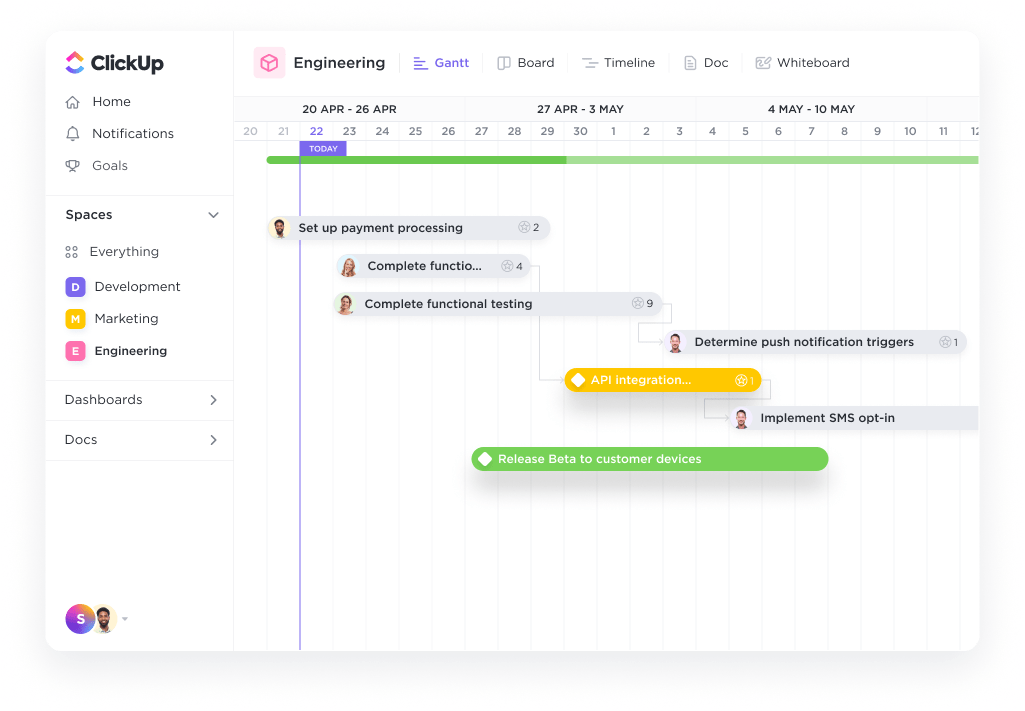
احصل على صورة واضحة لمهامك وتبعياتها في طريقة عرض ClickUp Gantt
إذا كنت ترغب في تصور التبعيات أو أنشطة سلسلة القيمة بأكملها، انتقل إلى ClickUp Whiteboards . يمكنك الحصول على لوحة لا نهائية لتوضيح سير عملك أو سلسلة منتجاتك باستخدام النصوص والموصلات والأشكال والملاحظات اللاصقة ومكونات الوسائط الأخرى. وهي تدعم العديد من المتعاونين المباشرين، مما يجعلها أداة مثالية للعصف الذهني للفرق البعيدة.
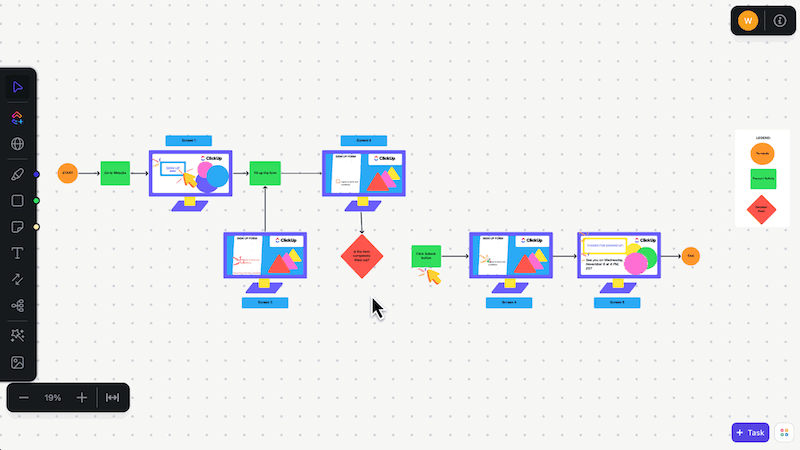
استخدم ClickUp لتصميم مهام سير العمل باستخدام ميزات مفيدة مثل اللوحات البيضاء والخرائط الذهنية والأتمتة والعديد من القوالب
الخطوة 5: أتمتة عملياتك وابتكارها لخفض التكاليف
أخيرًا، بمجرد أن تكون لديك فكرة عن أنشطتك الأساسية والأنشطة الثانوية وموقعها من حيث التكلفة، ابدأ في وضع استراتيجيات لخفض التكلفة. 👩🏭
اعتمادًا على نوع الأنشطة التي تقوم بتعديلها من أجل تمييز التكلفة، قد تحتاج إلى مساعدة من فرق تطوير المنتجات أو التسويق. على سبيل المثال، إذا كان من المفترض أن تأتي ميزة التكلفة من تعزيز أنشطة إدارة المنتج ، ثم يصبح فريق المنتج من أصحاب المصلحة المقربين في جميع أنحاء عملية التغيير .
ينتهي الأمر بالعديد من الفرق إلى ترقية البنية التحتية لشركاتهم من خلال إضافة أدوات الأتمتة إلى ترسانتهم. وتساعد الأتمتة على التخلص من العديد من العمليات المتكررة والزائدة عن الحاجة، مما يساعد على تحقيق التمايز في التكلفة دون عناء.
لحسن الحظ، باعتبارها أداة إدارة المنتج , يوفر ClickUp أكثر من 100 عملية تلقائية مدمجة لأتمتة العمليات المتكررة التي قد يقوم بها فريقك يدويًا. إنه لا يتضمن أي تعليمات برمجية بالكامل - ما عليك سوى تحديد حدث تشغيل وإجراء يجب اتخاذه عند تشغيل سير العمل ونشر الأتمتة. لا يتعلق الأمر بتقليل تكاليف العمالة فحسب، بل يتعلق أيضًا بالاهتمام بالعمليات المرهقة التي تسرق جزءًا كبيرًا من وقتك.

إعداد أتمتة مخصصة في ClickUp للمهام المتكررة
بمجرد الانتهاء من وضع خطة تحسين التكلفة، استخدم أهداف ClickUp لتتبع وإدارة تكاليفك مقابل الأهداف التي حددتها. يمكنك ربط أهدافك بالمهام الفعلية لمساعدة فريقك في العثور على الأسباب الكامنة وراء التغييرات المقترحة. تصور أهدافك من خلال تقارير مثل أشرطة التقدم والمخططات الخطية على ClickUp Dashboards .

تتبُّع تقدم المهام في لوحة معلومات أهداف ClickUp
النهج 2: تحليل ميزة تمايز المنتج أو الخدمة
يهدف هذا النوع من التحليل إلى تمييز منتجك أو خدمتك عن منافسيك من خلال إضافة ميزة أو ميزة فريدة توفر قيمة كبيرة للعملاء. هذه الميزة يجب أن تحسن عرضك ويصعب تكرارها بالنسبة لمنافسيك. دعنا نرى كيف يمكنك إجراء تحليل سلسلة القيمة للوصول إلى تمييز المنتج أو الخدمة:
الخطوة 1: حدد المساهمين الأساسيين في القيمة الأساسية لديك
ليست كل الأنشطة التجارية مؤثرة بنفس القدر على تجربة العميل وقيمته. إن تحديد العمليات ذات القيمة المنخفضة هو المفتاح الأساسي للتوصل إلى مزايا التمايز الرئيسية للمنتج. ويمكنك القيام بذلك من خلال جمع وتحليل ملاحظات العملاء أو المستخدمين لأنهم وحدهم القادرون على تحديد نقاط الألم التي يعانون منها وما الذي سيحقق لهم قيمة أكبر.
إن ClickUp CRM لديه مجموعة غنية من الوظائف لمساعدتك هنا. بدءًا من تصنيف حسابات عملائك إلى تبسيط التواصل مع العملاء وخط الأنابيب الرئيسي، فهو يدعمك في كل شيء.
على سبيل المثال، إذا كنت ترغب في جمع ملاحظات العملاء بطريقة منظمة، فسوف تحب نماذج ClickUp . قم بتخصيص نموذج الاستبيان الخاص بك بأسئلة خاصة بسلسلة القيمة الخاصة بك وتوزيعها عبر القنوات بنقرة واحدة. يتم تخزين الردود التي تم جمعها تلقائيًا في مساحة العمل الخاصة بك. يمكنك الانتقال إلى عرض الجدول لتحليلها في مكان واحد.

قم بتخصيص نماذج الملاحظات وإرسالها إلى عميلك عند بدء عملية تقييم الملاحظات الطوعية
الخطوة 2: ابحث عن عامل (عوامل) التمايز الرئيسية المستدامة
بمجرد أن تقوم بتحليل ملاحظات العملاء وتحديد المساهمين الرئيسيين أو الثغرات في سلسلة القيمة الخاصة بك، فكر في طرق للتحسين. الابتكار هو المفتاح، وقد ترغب فرق تطوير المنتجات الخاصة بك في ابتكار بعض الميزات الجديدة بناءً على تمايز المنتج أو الخدمة المطلوبة. 🦄
ولكن ليست كل التحسينات مستدامة من منظور مالي أو تشغيلي. بعض تحسينات العمليات التجارية تزيد من تكاليفك بشكل كبير، في حين أن البعض الآخر معقد للغاية بحيث لا يمكن أن يتناسب مع أعمالك.
هل تحتاج إلى مساعدة في تحديد التمايز الذي يجب تنفيذه؟ يمكنك استخدام قالب مصفوفة تحديد أولويات ClickUp لتحديد مدى استدامة كل تحسين مقترح للقيمة. ما عليك سوى رسم كل فكرة على المحورين X و Y في هذا القالب بترتيب التأثير والجهد. ستحصل أنت وأصحاب المصلحة لديك على رؤية مرئية حول أي تحسينات القيمة مستدامة وتستحق التنفيذ.
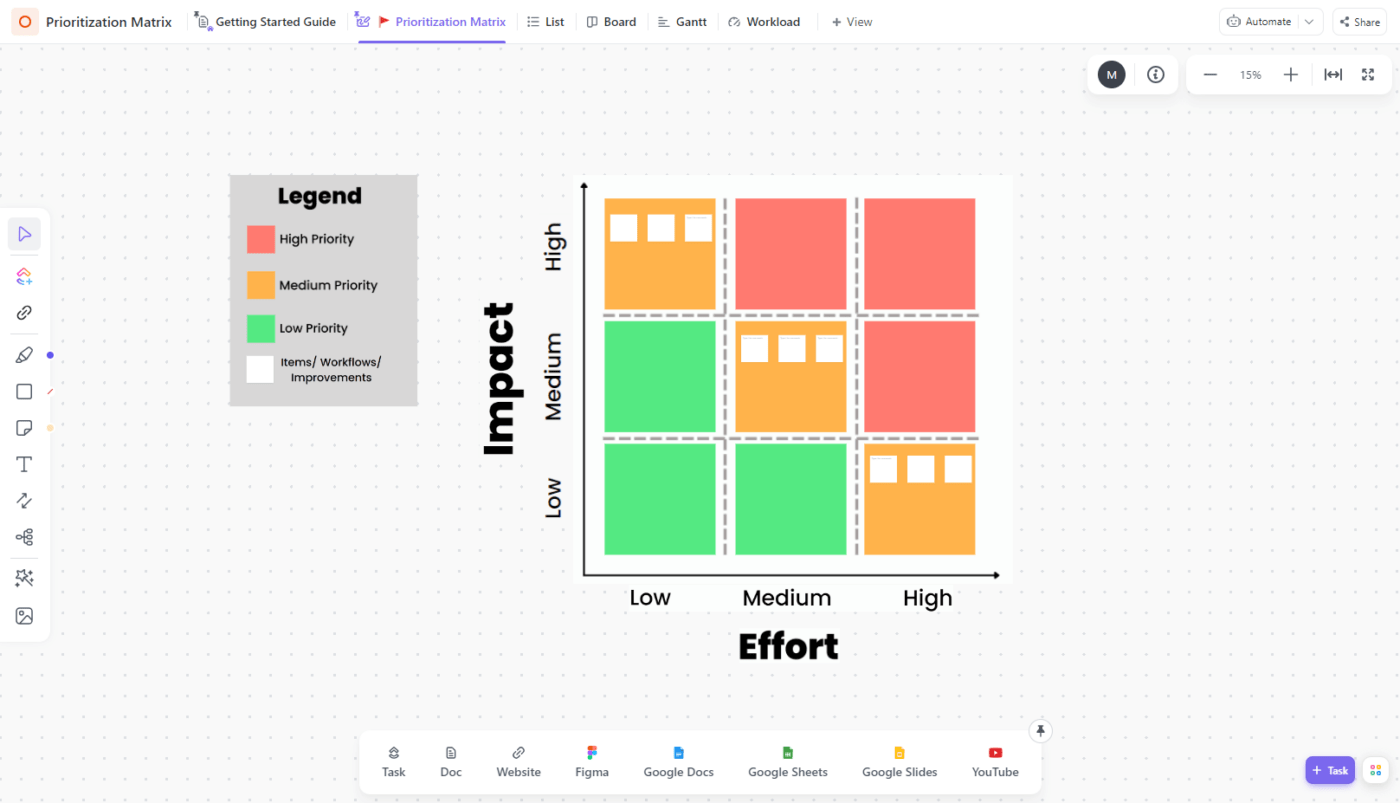
استخدم نموذج مصفوفة تحديد الأولويات من ClickUp لتحليل تأثير الأنشطة والجهود المطلوبة لها
/ctaBtn/الأخضر https://app.clickup.com/signup?template=t-200532794 قم بتنزيل هذا القالب /%ctaBtntn/
الخطوة 3: حماية تمايزك
غالباً ما يتم التغاضي عن هذه الخطوة الأخيرة، لكنها مهمة للغاية. بمجرد أن تبتكر تقنيات تحسين العمليات التجارية لتحقيق تمايز المنتج أو الخدمة، ابتكر أيضًا بعض العمليات التي تسمح لك بحماية ميزتك. يساعدك ذلك على البقاء على صلة بالموضوع والحفاظ على ميزتك التفاضلية في السوق لفترة طويلة. 🔒
لذا، قدم براءة اختراع أو ضع طبقات من الحماية حول أفضل ممارساتك وأسرارك التجارية. أنشئ صوامع للمعلومات. افعل كل ما يلزم لحماية تمايزك، تاركًا مجالًا ضئيلًا للمنافسين لتكرار عروضك وإضعاف ميزتك التنافسية.
إذا كنت لا تزال تشعر بأنك عالق، يمكنك استخدام منصة ClickUp المصممة من قبل الخبراء قوالب تدفق القيمة مع أقسام مرمزة بالألوان لتصور العلاقة بين أنشطة عملك. إن قالب تخطيط تدفق القيمة ClickUp ممتاز للعصف الذهني لتقنيات المفاضلة بين المنتجات.
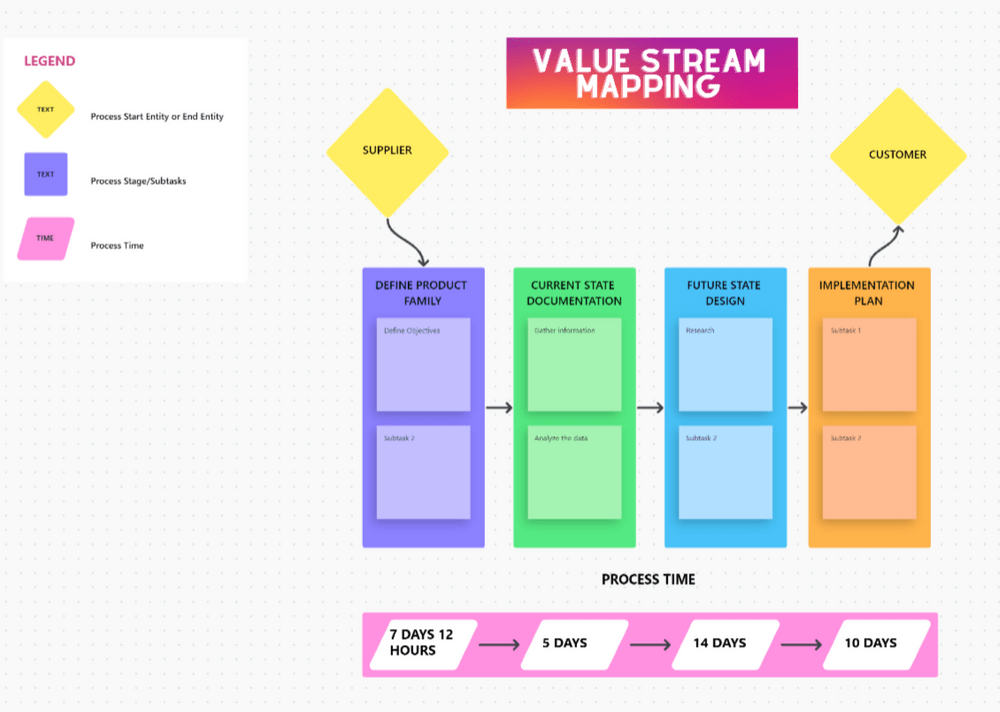
احصل على رؤى حول حالة عملياتك الحالية لاتخاذ قرارات وتحسينات أفضل على عملياتك
/ctaBtn/الأخضر https://app.clickup.com/signup?template=kkmvq-6327930 تنزيل هذا النموذج /%ctaBtntn/
قم بإجراء تحليل ناجح لسلسلة القيمة وابحث عن تمايزك باستخدام ClickUp
إذا كنت ترغب في الحصول على فهم شامل لعملياتك التجارية، فإن تحليل سلسلة القيمة هو السبيل إلى ذلك.
يمكن أن تساعدك قوالب ClickUp، واللوحات البيضاء، وعمليات التكامل، ومجموعة CRM في مراقبة إطار عمل سلسلة القيمة الخاصة بك وتحسينه باستمرار. إنها أتمتة سير العمل و تحسين العملية يمكن للميزات أن تساعد أعضاء فريقك على زيادة كفاءتهم إلى أقصى حد، مما يمنحك ميزة من حيث التكلفة.
إذن, احصل على ClickUp مجانًا وابدأ في الاستفادة منه للتقدم على منافسيك بثبات وثبات. 🫅

